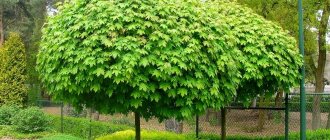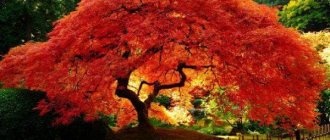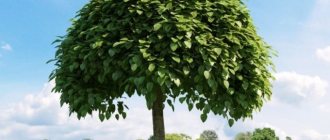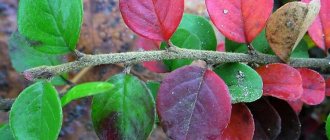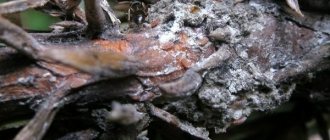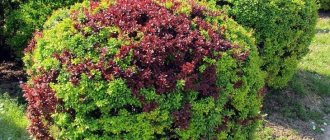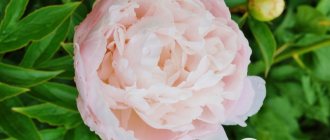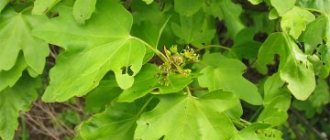Author: Elena N. https://floristics.info/ru/index.php?option=com_contact&view=contact&id=19 Category: Garden plants Published: February 18, 2019Last edits: April 14, 2021
- Growing from seeds
tree (lat. Acer platanoides), or sycamore maple, or sycamore maple , is a type of maple that is widespread in Western Asia and Europe. The northern border of the range of this species reaches the southern regions of Scandinavia, Karelia and Finland, and the southern border ends in northern Iran. Norway maple grows in mixed and deciduous forests in small groups or singly.
Planting and caring for Norway maple
- Planting: early spring or autumn.
- Lighting: bright light or light partial shade.
- Soil: well-drained, fertile, containing peat compost and humus.
- Watering: after planting - frequent, then - regular: water consumption per watering for an adult tree - 2 buckets, for a young tree - 4. Timely and sufficient moisture of the soil is especially important in dry and hot weather.
- Top dressing: from the second spring, the tree trunk circle is mulched with a layer of rotted manure 3 cm thick, and throughout the season tablets with slow release of nutrients are laid out in the root zone with the following frequency: until the end of spring - twice a month, until the end of summer - once.
- Pruning: only for sanitary purposes in early spring, before the buds awaken.
- Reproduction: by seeds, air and root layering.
- Pests: Mealybugs, whiteflies and leaf weevils.
- Diseases: coral spotting.
Read more about growing Norway maple below.
Wintering red maple
Red maple is a winter-hardy ornamental plant. It does not require special shelter for the winter. Only young seedlings can freeze in harsh snowless winters.
To cover a small tree, a frame is built, which is wrapped around with non-woven covering material. To prevent the roots from freezing, pour a thick layer of mulch into the tree trunk circle.
To successfully winter maple trees, stop feeding them with nitrogen-containing fertilizers in mid-summer. To prepare for frost, the tree only needs potassium and phosphorus. In the fall, before the soil freezes, you can carry out moisture-recharging irrigation, which will protect the root system from damage.
Botanical description
The height of Norway maple can reach 30 and sometimes more meters. Its trunk is covered with brownish-gray, almost black, fissured bark, and on young branches the bark is smooth, reddish-gray. The crown of the Norway maple is round in shape, with wide, strong branches directed downwards. The maple leaves are palm-shaped, simple, opposite, with large-toothed blades pointed at the ends, of which there can be 5-7 pieces. The upper side of the plate is dark green, the lower side is paler. In autumn, maple leaves turn yellow or orange. A milky juice oozes from the veins and petioles of broken leaves. The tree blooms in the first half of May with fragrant yellowish-green flowers, collected in corymbs of 15-30 pieces. Since Norway maple is a dioecious plant, its flowers are either female or male. The plant is pollinated by insects. The nectary, which is a flat ring into which the bases of the stamens are embedded, is located between the ovary and the petals. The fruit of the Norway maple is a lionfish that splits into two single-seeded fruits, ripens at the end of summer and sometimes does not fall from the tree until the end of winter. The plant is a honey plant.
Norway maple is very similar in appearance to another species - Canadian or sugar maple. They are distinguished primarily by the juice released from the petioles: in Canadian maple it is transparent. In addition, the autumn color of the leaves of the Canadian maple is brighter, and the bark is rougher and rougher. The leaf shape of the Canadian maple is not as lobed as that of the Norway maple. These two maples also differ in the type of buds: in the Canadian one they are bright green, while in the Norway maple they have a reddish tint.
Flamingo
A frost-resistant and unpretentious tree, its height is from 5 to 7 meters, grows up to 3 meters wide and has dense foliage. The oval leaves, pointed at the end, have small dissections along the edges, and reach a length of 10 cm.
During the season, they change color three times - in spring, light green leaves on pink cuttings are decorated with a wide pale pink border, later the border becomes white. In autumn, the foliage turns yellow or red with a white border.
Recent Entries
Lilac perennials that are beautiful, compact and do not crowd out other plants Why when buying seedlings you should not take the sellers’ word for it and how to determine the age of the plant using 3 signs Tomato seedlings have turned purple or whitish: why the color has changed and how to save the plants
The maple blooms in April, even before the leaves appear; small flowers are yellow in color and have long stamens; after two months, winged fruits appear. The tree is light-loving, but it is better to plant it in partial shade, because in the sun the leaves fade greatly and become pale.
Maple is not picky about soil, but will grow well in fertile, loose soil and regular watering, which promotes brighter color. To preserve the pink color in the spring, it is recommended to trim the maple tree to its stump every 3-4 years in the summer or fall - after this the leaves become larger and their color becomes brighter.
Planting Norway maple
Norway maple is planted in early spring or autumn. The distance from the maple to any other plant should be at least 2.5-3 m. When creating a hedge, Norway maple seedlings are placed at intervals of about 2 m. Norway maple is planted in a sunny or slightly shaded place in well-drained soil. The planting hole should be at least four times wider than the root ball, but equal in depth. However, when planting maple in an area with high groundwater levels, the hole must be made deeper so that it can accommodate a drainage layer of broken brick, crushed stone or screenings at least 15 cm thick.
- Kohleria - care, photos, types
Make sure that the root system of the seedling does not dry out before planting: soak its roots in water for several hours.
The fertile mixture that is to fill the hole should consist of three parts peat compost or humus, two parts turf soil and one part sand. You need to throw 120-150 g of Nitroammophoska to the bottom of the hole, then lower the roots of the seedling into the hole, straighten them and fill the space with a fertile mixture. The root collar of the seedling should be several centimeters above the surface. After planting, at least three buckets of water must be poured into the maple tree trunk, and when it is absorbed and the soil settles, the root collar will be where it should be - at surface level. In the coming days, the area around the seedling should be covered with a layer of peat or dry soil 3-5 cm thick.
How does maple spread?
In nature, Norway maple easily reproduces by seeds and root shoots. Young plants appear in abundance around the stumps of old maples. Wind-dispersed seeds germinate, becoming dense undergrowth.
If you want to very easily propagate the plant on your own. To harden the seeds, they are planted in the soil in the fall. Seedlings with several leaves dive in the spring. Subsequent care before planting the Norway maple in a permanent place consists of constant watering, weed control and protecting the seedlings from the cold.
You can bring a seedling from the forest. In this case it is important:
- choose a strong 1-3 year old plant without signs of diseases or damage to the trunk;
- if it is possible to save a lump of earth that hides the roots;
- Before planting, treat the roots, trunk and crown with a solution of fungicides and insecticidal preparations so as not to introduce pathogenic fungi and pests into the area.
With the emergence of unusual ornamental varieties, the gardener became interested in how maple with variegated and anthacian foliage color spreads? Such plants reproduce vegetatively using air or root layering.
Norway maple care
Growing conditions
After planting, maple trees need to be watered frequently. But not only seedlings, but already strong and even mature maples need regular watering, especially in summer. Water them once a month in spring and autumn and every week in summer. Consumption per adult plant is about 2 buckets, and young maples need twice as much water. However, if the leaves of the tree have acquired a too light green tint, this indicates that you have overdone the soil moisture. And drooping leaves are a sign of insufficient watering. After moistening the soil, the tree trunk circle is loosened from time to time, at the same time removing weeds that have appeared in the root zone.
If you added fertilizer to the hole when planting, the maple will not need feeding until the end of the current season. From the second spring, rotted manure is used as a fertilizer, a layer of which 3 cm thick is evenly mulched around the tree trunk. The plant responds well to slow-release nutrient tablets, which are placed in the root zone twice a month from the beginning of the growing season until the end of spring, and then once a month until the end of summer.
The dormant period of the maple lasts from the first frost until March. Young plants need to be covered for the winter: the Norway maple trunk is wrapped in burlap and tied with rope - both from frost and from rodents. It is imperative to cover the root neck of the tree with spruce branches. With age, maple frost resistance increases, and these measures will become unnecessary.
Trimming
Pruning of Norway maple is carried out exclusively for sanitary purposes: broken, frozen, dry or disease- or pest-affected shoots and branches, as well as root shoots are removed. To make the tree look neat, you can shorten the shoots that stick out to the sides and cut out those that grow inside the crown. The beautiful spherical crown of Norway maple does not need formative pruning.
- Hyacinths - cultivation
Pests and diseases
A characteristic disease for maples is coral spotting, which is manifested by the death of branches and the formation of small burgundy spots on the tree bark. Affected branches must be removed immediately, and the cuts must be treated with garden varnish. Both before and after pruning, garden tools need to be disinfected.
Insects that harm Norway maple include mealybugs, whiteflies and leaf weevils. Whitefly larvae are destroyed by treating the maple with Ammophos, after cutting out and setting on fire the branches affected by them. The occupation of maple by mealybugs can be avoided if you treat the tree leaf by leaf with Nitrafen until the buds swell, and the remedy for weevils is a solution of Chlorophos, prepared in accordance with the instructions and used to treat the tree leaf by leaf.
Pruning and crown formation
As a rule, maples naturally have beautiful spreading, conical, pyramidal or rounded crowns that do not require formative pruning. In spring and autumn, when the movement of sap is slow, sanitary pruning of branches is carried out, removing dried and frozen shoots affected by pests or diseases.
Excess root growth and shoots of competitors that thicken the crown and intersect with each other are also cut out. With age (about 10 years after planting), the skeletal branches of the tree can be shortened by 2/3. If the height of the tree needs to be kept at a certain level, the top is trimmed annually.
Norway maple propagation
Growing from seeds
Maple is easily propagated by seed. Sow the seeds in a seedling bed in the fall so that they undergo natural stratification during the winter months. In the spring, friendly shoots will appear that will need to be planted. You can sow in March, but in this case you will have to stratify the seeds for 5-7 days in the vegetable drawer of the refrigerator, placing them in a container with wet sand.
Reproduction by air layering
On the branch from which you are going to make a layer, you need to use a sterile sharp knife to cut the bark obliquely several times and treat the adjacent cuts with a root former (Heteroauxin or Kornevin). Beads of foam plastic are inserted into the cuts so that their edges do not close again, after which the wounds should be covered with damp moss, and a plastic bag should be placed on top of this part of the branch, securing it tightly above and below the cuts. After this, cover the bag from the sun with canvas or aluminum foil.
Gradually, roots will begin to grow in the places of the cuts, which will be immersed in moist sphagnum. Next spring, during the time of active growth, the cuttings are separated from the maple, freed from polyethylene, foil or fabric and planted in the ground together with sphagnum.
Reproduction by root layering
Several cuts are also made on the root shoots closer to the surface of the earth, treated with a root-forming solution and hilled high, covering the cuts with soil. During the season, water and hill up the cuttings: by next spring they will have developed their own roots, and you can dig them up and plant them in a new place.
Plant propagation methods
Some varieties produce abundant root shoots. To propagate such trees, it is enough to dig up a young seedling in the spring, separate it from the mother tree, and plant it in a new place.
Varietal maples are propagated in two ways:
- Seeds.Before planting, maple seeds require stratification. They can be kept for 3 months in the refrigerator at a temperature of 0 to 4 °C. Or sow seeds in open ground in the fall at a depth of 3–5 cm. Young shoots appear from them in the spring, which are best covered for next winter.
- By cuttings and grafting. This method is more often used in garden centers to obtain good quality seedlings. Cuttings of varietal maples are grafted onto a ready-made rootstock with a developed root system.
When growing maples, it is necessary to control their spread, as this easily occurs by self-seeding, and weed out unwanted shoots in a timely manner.
Norway maple varieties
Norway maple has several decorative forms and many varieties. The most commonly used is the spherical form of maple - a slow-growing tree, which is grown by grafting into a trunk or into the root collar, which achieves the bush-like appearance of the plant. The standard form is used in alley and single plantings. To decorate lawns, it is grafted into the root collar. The palm-cut form of the maple is a showy plant with dark green leaves that are separate to the base. Norway maple Drummond is a tree with pink leaves when budding and then white edged leaves, which makes an indelible impression with its unusual beauty. The shape of the Golden Globe is a tree with a spherical crown and golden foliage.
- How to prepare hydrangea for winter: pruning and covering
The most commonly grown Norway maple varieties are:
- Norway maple Globosum is a tree no higher than 7 m with a crown diameter of 3 to 5 m. The leaves of the plant are palmate, consisting of 5 parts. They are pink when they bloom, then turn dark green and yellow-orange in the fall;
- Norway maple Crimson King is a tree up to 20 m high with a crown shape typical for a plant of this species and leaves that are richly purple, almost black throughout the season. When they bloom, they are bright red with pink cataphylls, then the leaves gradually darken to a burgundy hue, and in the fall the upper side of the plate acquires a purple tint;
- Norway maple Crimson Sentry is a slender tree up to 20 m high and with a crown diameter of up to 8 m. The branches of this variety are directed upward, the palmately divided bright red leaves consist of five parts;
- Norway maple Deborah is a plant up to 20 m high with a crown width of up to 15 m. Five-seven-lobed leaves with a slightly wavy edge reach a length of 15 and a width of 20 cm. When they bloom, they are shiny, purple-red on the upper side, and on the lower side – dark green. Then the upper part of the plate gradually turns green and eventually acquires a brown tint, and in the fall the leaves become yellow-orange;
- Norway maple Emerald Queen is a fast-growing tree up to 15 m high with a crown diameter of up to 10 m, palmate-lobed leaves, bronze when blooming, then turning green, and turning yellow in autumn;
- Norway maple Faassens Black - a tree of the same size with light red leaves up to 15 cm wide when blooming, which gradually darken, becoming shiny, almost black with a purplish-violet tint;
- Norway maple Royal Red - the height of this tree is from 8 to 12 m. The leaves are blood-red when blooming, then they become black-red and shiny, and turn red again in the fall;
- Farlakes Green is a red Norway maple whose leaves then turn dark green and turn bright yellow in the fall. This tree with an ovoid crown reaches a height of 12-15 m;
- Cleveland - the diameter of the broadly ovoid crown of this variety can reach from 6 to 8 m with a tree height of 12-15 m. Over time, the crown becomes almost spherical. The plant's five-part palmately lobed leaves are light green in April, then turn dark green and bright yellow in the fall.
Spreading
Due to its long life expectancy, maple is widespread in the Northern Hemisphere. It can be found both in the polar regions of North America and Europe, and in the tropical regions of South Asia and Central America. This tree is mainly distributed in temperate latitudes, while in the Southern Hemisphere only laurel maple is known.
There are about 20 species of maple on the territory of our state. The lifespan of trees is quite high. The most common are holly, tartar, field and white. As a rule, they grow in the European part of the country, but you cannot find them in Siberia. It should be noted that Japanese maple is even listed in the Red Book of the Russian Federation.
In the south, maples prefer to grow in mountainous areas. They feel great in the Himalayas at an altitude of up to three thousand meters above sea level. On the plains, only a few species grow, and then alone or in small groups. Such trees almost never form independent forests.
Norway maple in landscape design
Gardeners in England, Germany and Holland often use large trees with variegated or brightly colored foliage in landscaping, so the varietal diversity of Norway maple opens up great opportunities for landscape designers. For example, the slope of a ravine or mountain, planted with maples with purple, yellow or variegated foliage, looks like the scenery of a fairy tale.
As for the design of summer cottages and garden plots, even a single Norway maple of the Crimson King variety adds a unique flavor, and if you create a composition of ornamental shrubs and trees with its participation, you can achieve much greater success. This task is not easy, since when planting seedlings it will be necessary to take into account not only the color compatibility of the plants, but also their future size. However, with correct calculations and good theoretical preparation, this task is feasible.
Types of maples in Russia
In the European part you can find only 4 species:
- Norway maple;
- Tatar;
- pseudo-sycamore, or white;
- field.
In the Far East there are:
- river maple;
- small-leaved;
- false Siebolds;
- green-skinned;
- Japanese;
- maple-birch;
- bearded;
- Manchurian;
- Chonoski maple;
- palm-shaped.
In the Caucasus, in addition to the above, grow:
- alpine maple;
- Colchian;
- Montpelian;
- Sosnovsky maple, which is listed in the Red Book of the Krasnodar Territory.
Thickets of euonymus "Northern Tushin" and water landscapes
The maple alley of the Khodynskoye Pole park will also be an excellent place for a photo shoot. It runs along the outer border of the park - from the skate area to the monument to M.V. Vodopyanov. On both sides of the central path there are spreading trees with carved colorful leaves. Visitors can enjoy the beauty of the colors - the bright burgundy and yellow maple leaves will not leave anyone indifferent. And of course, you can take photos in the mirror maze - this is one of the most popular places for great shots.
The embankment of the Khimki Reservoir in the Northern Tushino Park . In the northern part of the park, not far from the observation deck, an unusual ornamental shrub grows - euonymus. In summer its leaves are green and smooth. And with the onset of autumn, its foliage is painted in purple, scarlet, bronze and yellow tones. The decorative effect of the euonymus is added by ripening fruits in the form of bright crimson boxes.
In the northern part of the Levoberezhye recreation area, on the opposite bank from the beach, there is an observation deck with a wooden pergola and benches. The branches of trees growing on the shore near the observation deck practically touch the water. The sun's rays penetrate the foliage and draw intricate patterns. This part of the park is always not crowded. The secluded atmosphere will create a special mood, and the photos will turn out to be truly romantic. To find the site, you need to enter the park from Levoberezhnaya Street, and then go down to the water.
In Dubki Park you will get the most picturesque landscape photographs. Walking along the alley in its shady part, you can not only enjoy the beauty of a quiet corner of nature, but also take pictures of the paths leading into the distance and the spreading crown of trees. At the entrance to the park, next to the monument “To the Timiryazevites who laid down their lives for their faith, Fatherland and people,” Norway maples grow. And near the pond in the center of the park there are spreading spherical willows. This place will appeal to those who like to play with reflections on the surface of the water - you can take long shots with a view of the pond, wooden bridge and rotunda of the park.
Human activity
There is another factor that affects the life expectancy of the common maple - this is the cutting down of trees. The main area of application of this wood is furniture production. Maple is a noble material that has a beautiful cut pattern and can be easily processed and varnished. The high hardness of the wood ensures the stability of the fasteners, resulting in maple furniture to last for a very long time.
The beautiful appearance of maple is suitable for the production of laminated veneer lumber, which may include cheaper tree species. In addition, soundboards for musical stringed instruments are made from this material, but maple veneer is used in the production of professional drums.
Pests and diseases
The lifespan of a maple tree depends on many factors, including diseases and pests. Maple leaves are very fond of being eaten by various lepidopteran larvae. In addition, aphids often settle on trees, which can result in their death. It is worth noting that even the stress that the plant experiences during a drought can affect the lifespan of a maple tree.
Next, let's look at some diseases that can cause irreparable harm to a tree:
- Powdery mildew affecting maple leaves.
- Maple canker causes wrinkling and scarring of the bark. This causes open wounds to form and the entire branch to die, with adjacent branches forming growths in an attempt to prevent the tree from becoming infected. To prevent this problem, the affected areas should be cut back until healthy wood is visible. Then the tree is lubricated with a fungicidal preparation and garden varnish. In autumn, during leaf fall, the plant is sprayed with a fungicidal solution.
- Witch's broom causes the rapid development of dormant buds, causing the branches to take on the appearance of a broom. Such branches should be cut off immediately.
- Coral spotting provokes drying out and further death of individual shoots and branches. The parasite penetrates the conducting vessels of the tree, resulting in the formation of red pustules. In order to prevent this, the affected parts are cut off and treated with a solution of fungicide with copper.
- Drying of branches leads to cracking of the bark, which is detrimental to the tree.
- Resin spotting is fraught with the formation of discolored areas on maple leaves with a black crusty spot in the center. Diseased leaves are removed, and the tree is treated with a fungicidal solution and fed with nitrogen-based fertilizer. When the buds begin to bloom, this procedure is repeated.
- The lifespan of maples is also affected by cercosporiosis, a disease in which brown spots begin to appear on young shoots. As a result, the entire tree may die. To prevent this from happening, gardeners recommend treating the plant with a copper-based fungicidal solution.
- The gall mite is characterized by the appearance of green and red swellings on the upper side of the leaf, which subsequently change their shape and are filled with fluff. The affected tree is sprayed with sulfur preparations.
Insect pests include:
- bark beetles;
- woodworms and woodborers;
- scale insects;
- silkworms;
- moths;
- aphid.
Applications of maple wood
Maple wood is suitable for making parquet boards, musical instruments, skis and much more.
Maple wood has gained popularity due to its strength and ease of processing.
Maple is very popular among woodcarving enthusiasts, as it has high resistance.
- Maple wood allows you to make thin cuts without cracking or splitting.
- Maple details are unique and sophisticated.
- The art of wood carving called intarsia uses only maple wood.
The essence of intarsia is to select maple wood of different colors in order to cut it into ribbons. The resulting tapes are glued together and mosaics are cut out to create a pattern.
Imperial oaks in Kuskovo and the alleys of Perovsky Park
The Kuskovo Estate Museum will be a picturesque place for an autumn photo shoot . You can take a photo in the game alley behind the Dutch House. This is where the imperial oaks grow. They were planted by Emperor Alexander III. It is mostly uncrowded here - you can freely stroll through the manor park, rustling the leaves and taking lots of pictures.
And in the ground floor near the Big Stone Greenhouse there is a view of bright maples and other trees of various autumn shades.
The main alley of Perovsky Park is decorated with many different trees, each of which changes color in its own way, creating a palette of colors and shades. To find the alley, you need to walk from Kuskovskaya Street to the central square. The park's Kupavensky pond is especially beautiful in the fall - it is surrounded by trees, which, reflected in the water, create a beautiful backdrop. The pond is located in the northern part of the park from Perovskaya Street.
The alleys around the ponds of the Terletskaya oak grove with its wooden decks at the Eastern, Western and Kupalny ponds will replace a real photo studio. The alleys are surrounded by colorful trees, among which you can take beautiful pictures.
Through the mirror labyrinth and relict forest. Scenic cycling routes in parksLook at swans and Russian Venice in the gardens: a virtual guide to park ponds has been created
